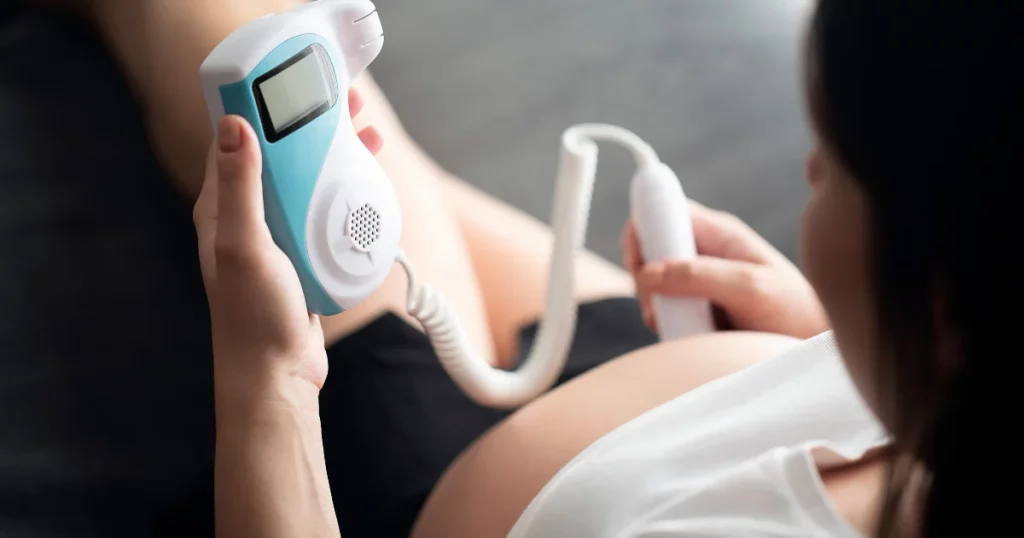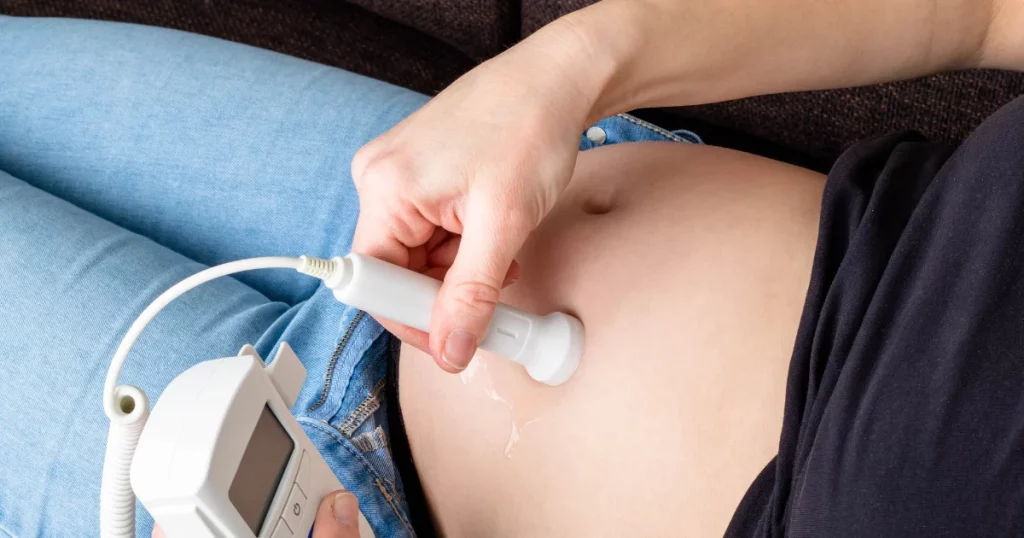Imagine the excitement of expectant parents eagerly anticipating the arrival of their little one. In the midst of this joyous journey, the heartbeat of their unborn baby becomes a source of immense fascination and comfort. Fetal heart monitors at home (FHM) offer parents the opportunity to listen to their baby’s heartbeat from the comfort of their own home. However, understanding how to use these devices responsibly and in conjunction with proper prenatal care is crucial. Let’s delve into the world of fetal heart monitors at home and explore everything you need to know to use them safely and effectively.
Table of Contents
Understanding Fetal Heart Monitors at Home
Fetal heart monitors at home (FHM) operate on the principle of ultrasound technology, emitting sound waves into the abdomen to detect and amplify the fetal heartbeat. These devices come in various types, with Doppler monitors being the most common. Doppler monitors use the Doppler effect to detect the movement of blood cells and translate it into audible sounds, allowing parents to listen to their baby’s heartbeat.
While fetal heart monitors at home offer a convenient way for expectant parents to bond with their unborn child and monitor fetal well-being, it’s important to acknowledge their limitations. Unlike medical-grade monitoring conducted by healthcare professionals, fetal heart monitors at home may not provide comprehensive information about fetal health and should not replace regular prenatal check-ups.
Safety Considerations
When using fetal heart monitors at home (FHM), it’s natural for expectant parents to have concerns about safety, particularly regarding ultrasound exposure. While limited research exists on the long-term effects of ultrasound exposure from fetal heart monitors at home, it’s essential to prioritize caution.
To minimize potential risks, it’s crucial for users to strictly adhere to the manufacturer’s instructions regarding safe usage and frequency of use. Overuse or improper use of fetal heart monitors at home could lead to unnecessary exposure to ultrasound waves, which may pose risks to both the mother and the developing fetus.
Moreover, it’s important to understand that fetal heart monitors at home readings are not intended for medical diagnosis or to replace professional monitoring. They should complement, rather than substitute for, regular prenatal check-ups conducted by healthcare professionals. If any concerns arise during at-home monitoring sessions, expectant parents should promptly seek guidance from their healthcare provider.
Also read: Internal Fetal Heart Monitor
Understanding When You Can Hear Your Baby’s Heartbeat
Typically, fetal heartbeats become detectable with a fetal heart monitor at home after the first trimester of pregnancy. However, various factors, such as fetal position and maternal body weight, can affect the ability to hear the heartbeat. It’s essential to manage expectations and understand that the absence of a heartbeat at home doesn’t necessarily indicate a problem.
A. Fetal Development Stages
During pregnancy, the fetal heart begins to develop around the third week of gestation. By the end of the first trimester (around 12 weeks), the fetal heart has formed and begins to beat rhythmically. This marks the beginning of when a heartbeat might be detectable using fetal heart monitors at home (FHM).
B. Factors Affecting Detection
Several factors can influence the ability to detect the fetal heartbeat:
1. Gestational Age: The fetal heartbeat becomes more audible as pregnancy progresses, typically becoming clearer after the first trimester.
2. Fetal Position: The position of the fetus within the womb can affect the ease of detecting the heartbeat. For example, suppose the fetus is positioned toward the back of the uterus (posterior position). In that case, it may be more challenging to hear the heartbeat than when it’s closer to the front (anterior position).
3. Maternal Body Weight: Maternal body weight and abdominal fat can create additional layers of tissue between the fetal heart and the surface of the abdomen, potentially making it more difficult to detect the heartbeat with at-home monitors.
C. Importance of Understanding
Expectant parents need to understand that not being able to hear the fetal heartbeat at home does not necessarily indicate a problem. Factors such as fetal position, maternal body weight, and the sensitivity of the monitor can all contribute to variations in detecting the heartbeat. If there are concerns about the baby’s well-being, it’s advisable to consult a healthcare provider for further evaluation and reassurance.
Fetal Heart Monitors at home can offer expectant parents the opportunity to bond with their baby and provide reassurance during pregnancy. However, it’s essential to understand the factors that can affect the ability to detect the fetal heartbeat and to seek professional guidance if there are any concerns. By staying informed and seeking appropriate medical advice, expectant parents can navigate the journey of pregnancy with confidence and peace of mind.
When Can Fetal Heart Monitors at Home Be Helpful?
While Fetal Heart Monitors at home can offer reassurance in certain situations, such as feeling reduced fetal movement, they cannot detect all potential complications. Consulting a healthcare professional for any concerns or abnormal readings is essential to ensure the baby’s well-being.
A. Limited Situations for Reassurance
Fetal Heart Monitors at home (FHM) can offer reassurance in certain situations, including:
1. Bonding and Connection: Using Fetal Heart Monitors at home can provide expectant parents with a sense of connection to their baby by allowing them to hear the fetal heartbeat between prenatal visits.
2. Peace of Mind: For individuals who have experienced previous pregnancy complications or miscarriages, being able to monitor the fetal heartbeat at home may offer peace of mind and alleviate anxiety during the early stages of pregnancy.
3. High-Risk Pregnancies: In some cases, healthcare providers may recommend Fetal Heart Monitors at home monitoring for individuals with high-risk pregnancies, such as those with a history of pregnancy complications or medical conditions that require close monitoring.
B. Limitations and Considerations
It’s important to recognize that Fetal Heart Monitors at home have limitations and cannot detect all potential complications. Factors such as fetal movement, maternal positioning, and the sensitivity of the monitor can affect the accuracy of the readings. Additionally, Fetal Heart Monitors at home should not replace regular prenatal care or medical evaluations by a healthcare professional.
C. Consulting a Healthcare Professional
If there are any concerns or abnormal readings during Fetal Heart Monitor at home sessions, it’s crucial to consult a healthcare professional promptly. A healthcare provider can provide personalized guidance, perform additional assessments if necessary, and offer reassurance or interventions as needed. Remember that the well-being of both the mother and the baby is best ensured through comprehensive prenatal care and medical supervision.
While fetal heart monitors at home can offer convenience and reassurance to expectant parents, they should be used judiciously and in conjunction with regular prenatal care. Understanding the limited situations where Fetal Heart Monitors at home can be helpful, acknowledging their limitations, and consulting a healthcare professional for guidance are essential steps in promoting a healthy pregnancy journey.
Using Your Fetal Heart Monitor at Home(FHM)

Utilizing a Fetal Heart Monitor at home involves following step-by-step instructions provided by the manufacturer. It’s advisable to apply ultrasound gel for optimal signal transmission and adhere to safe usage guidelines strictly. Visual aids, such as diagrams or short video clips, can assist in understanding the proper usage of the device.
A. Step-by-Step Instructions:
1. Prepare the Device:
– Ensure the Fetal Heart Monitor at home device is fully charged or has fresh batteries.
– Familiarize yourself with the device’s buttons and functions by referring to the user manual.
2. Find a Comfortable Position:
– Sit or lie down in a comfortable position, preferably on your left side, as it improves blood flow to the uterus and baby.
3. Apply Ultrasound Gel:
– Apply a small amount of ultrasound gel to your abdomen where you expect to find the baby’s heartbeat. This gel helps transmit the ultrasound waves and improve signal quality.
4. Turn on the Device:
– Power on the Fetal Heart Monitor at home device and adjust the volume to a comfortable level.
5. Locate the Heartbeat:
– Place the device’s ultrasound probe gently on your abdomen, moving it around until you locate the fetal heartbeat. Start near your pubic bone and gradually move upward.
6. Listen Carefully:
– Once you’ve found the heartbeat, listen carefully for the rhythmic sound resembling a horse galloping. This is your baby’s heartbeat.
7. Record or Monitor:
– Some Fetal Heart Monitors at home allow you to record the heartbeat or display it on a digital screen. Follow the device’s instructions for recording or monitoring the heartbeat.
8. Note the Heart Rate:
– Pay attention to the heart rate displayed on the device, typically measured in beats per minute (bpm).
9. Turn Off the Device:
– After you’ve finished monitoring, turn off the Fetal Heart Monitor at home device to conserve battery life.
B. Tips for Optimal Use:
Consult the Manual: Always refer to the specific user manual provided with your Fetal Heart Monitor at home device for detailed instructions on usage and maintenance.
Use Gel Sparingly: Apply only a small amount of ultrasound gel to prevent messiness and ensure optimal signal transmission.
Follow Safety Guidelines: Adhere to manufacturer guidelines regarding safe usage, including frequency and duration of monitoring sessions, to minimize any potential risks.
C. Visual Aid
Consider referring to visual aids such as diagrams or short video clips provided in the device manual for additional guidance on using your Fetal Heart Monitor at home.
D. Disclaimer
Remember that while Fetal Heart Monitors at home can provide reassurance and bonding opportunities, it should not replace regular prenatal care or medical evaluations by a healthcare professional. If you have any concerns or questions about your pregnancy, always consult with your healthcare provider promptly.
Responsible Use of Fetal Heart Monitors at home (FHM)
Responsible use of Fetal Heart Monitor at home entails managing expectations and recognizing their limitations. It’s crucial to prioritize regular prenatal checkups and maintain open communication with healthcare providers regarding the use of Fetal Heart Monitor at home. Remember, these devices are not substitutes for professional medical monitoring.
- No Guarantee of Fetal Well-being: While a Fetal Heart Monitor at home can provide glimpses into the baby’s well-being, it’s crucial to understand that it does not guarantee the absence of complications or fetal distress.
- Avoid Sole Reliance: Fetal Heart Monitor at home should complement, not replace, regular prenatal care. It’s essential to attend scheduled prenatal checkups with healthcare providers for comprehensive assessments of fetal health and maternal well-being.
- Consult Healthcare Providers: Maintain open communication with your healthcare provider about your use of an Fetal Heart Monitor at home. Share any concerns or questions you may have and seek guidance on using the device responsibly.
By managing expectations, avoiding sole reliance on Fetal Heart Monitor at home, and maintaining open communication with healthcare providers, expectant parents can use these devices responsibly as part of their prenatal care routine. Remember, the primary goal is to ensure the health and well-being of both the baby and the mother throughout pregnancy.
Interpreting the Sounds You Hear with a Fetal Heart Monitor at Home
While using a Fetal Heart Monitor at home, you may hear various sounds, including the fetal heartbeat and a whooshing sound. However, interpreting these sounds requires training and expertise. It’s essential to consult a healthcare professional if you encounter any concerns or abnormal sounds during monitoring sessions.
A. Basic Sounds
- Fetal Heartbeat: The most prominent sound you’ll likely hear is the rhythmic thumping of your baby’s heartbeat. It’s typically faster than the mother’s heartbeat and can vary in intensity.
- Whooshing Sound: Alongside the heartbeat, you may hear a whooshing or swishing sound, which is often the blood flow through the placenta and umbilical cord.
B. Interpretation Caution
- Expertise Required: Interpreting these sounds accurately requires training and expertise. While it’s natural to want to understand what you’re hearing, it’s essential to remember that Fetal Heart Monitor at home readings are not diagnostic.
- Not Diagnostic: The sounds heard through a Fetal Heart Monitor at home do not provide a comprehensive assessment of fetal health or well-being. They offer glimpses into the baby’s activity but should not be relied upon for diagnosis.
C. Consult Healthcare Professional
- Seek Guidance: If you have any concerns or hear abnormal sounds during Fetal Heart Monitor at home use, it’s crucial to consult a healthcare professional promptly.
- Expert Input: Healthcare providers have the expertise to interpret fetal heart sounds accurately and can provide guidance based on your specific situation.
While listening to your baby’s heartbeat with a Fetal Heart Monitor at home can be a heartwarming experience, remember that interpreting these sounds requires expertise. Always consult a healthcare professional if you have any concerns or questions about what you hear. Their guidance ensures the best possible care for you and your baby throughout pregnancy.
Limitations of Fetal Heart Monitor at home
Compared to medical-grade monitoring, Fetal Heart Monitor at home has limitations, including difficulty in detecting all potential complications and interpreting abnormal heart rate patterns. It’s vital not to rely solely on a Fetal Heart Monitor at home and to prioritize professional prenatal care.
A. Inability to Detect All Complications
Fetal Heart Monitor at home may not detect all potential complications or abnormalities that can arise during pregnancy. Certain conditions require specialized medical equipment and expertise for accurate diagnosis.
B. Difficulty Interpreting Abnormal Patterns
Interpreting fetal heart rate patterns accurately requires training and expertise. Without proper knowledge, it can be challenging to distinguish normal variations from concerning abnormalities.
C. Limited Information About Fetal Well-being
Fetal Heart Monitor at home provides limited information about overall fetal well-being. While hearing the baby’s heartbeat can offer reassurance, it doesn’t provide a comprehensive assessment of fetal health or development.
D. Importance of Regular Prenatal Care
It’s crucial not to rely solely on a Fetal Heart Monitor at home for monitoring fetal health. Regular prenatal checkups with healthcare professionals are essential for comprehensive assessments and timely interventions if needed.
While a Fetal Heart Monitor at home can be a valuable tool for bonding with your baby and experiencing their heartbeat, it’s essential to recognize its limitations. Prioritizing regular prenatal care and consulting healthcare professionals for any concerns ensures the best possible outcomes for you and your baby.
Alternatives to Fetal Heart Monitor at home
Exploring alternative methods for monitoring fetal well-being, such as feeling the baby move (quickening), can complement the use of a Fetal Heart Monitor at home. Additionally, focusing on regular prenatal care visits and doctor-performed monitoring ensures comprehensive care for both mother and baby.
A. Feeling the Baby Move (Quickening)
Feeling your baby’s movements, known as quickening, is a natural and reassuring sign of fetal well-being. As pregnancy progresses, you’ll likely begin to feel gentle flutters, kicks, and rolls. Pay attention to these movements as they provide valuable insights into your baby’s health and development.
B. Focusing on Prenatal Care Visits
Regular prenatal care visits with your healthcare provider are essential for monitoring your baby’s growth and development. These appointments include ultrasound scans, Doppler heartbeat checks, and other assessments to ensure your baby is healthy and thriving.
C. Doctor-Performed Monitoring
Trusting medical professionals to perform fetal monitoring during prenatal visits offers comprehensive assessments of fetal well-being. Doctors use specialized equipment and techniques to monitor the baby’s heart rate, movement, and overall health, providing invaluable insights and peace of mind.
D. Early Detection of Reduced Fetal Movement
If you notice a significant decrease in your baby’s movements or have any concerns about fetal well-being, don’t hesitate to contact your healthcare provider immediately. Early detection of reduced fetal movement can prompt timely interventions to ensure the best outcomes for you and your baby.
E. Importance of Medical Expertise
While DIY methods like Fetal Heart Monitor at home may offer temporary reassurance, they cannot replace the expertise and comprehensive monitoring provided by healthcare professionals. Trusting your healthcare team and prioritizing regular prenatal care visits are essential for optimal maternal and fetal health.
Exploring alternative methods for connecting with your baby and monitoring fetal well-being can enhance your pregnancy journey. By prioritizing regular prenatal care visits, doctor-performed monitoring, and early detection of reduced fetal movement, you can ensure the best possible outcomes for you and your baby.
Responsible Use and Managing Expectations
Emphasizing responsible use and managing expectations is key when utilizing Fetal Heart Monitor at home. Avoid using these devices for diagnosing pregnancy or predicting fetal gender. Instead, trust your healthcare team, prioritize regular checkups, and enjoy the journey of pregnancy with peace of mind.
A. Not a Substitute for Professional Monitoring
It’s crucial to understand that Fetal Heart Monitor at home is not a replacement for professional monitoring by healthcare providers. While it can offer reassurance, it cannot provide the comprehensive assessment and expertise offered during prenatal visits.
B. Not for Diagnosis
Fetal Heart Monitor at home should not be used for diagnosing pregnancy or predicting fetal gender. Its primary purpose is to bond with your baby and listen to their heartbeat, not to make medical assessments.
C. Open Communication with Healthcare Providers
Maintain open communication with your healthcare providers about your use of a Fetal Heart Monitor at home. They can provide guidance on how to use it safely and offer insights into interpreting the results.
By managing expectations, avoiding misuse, and maintaining open communication with healthcare providers, you can ensure responsible use of a Fetal Heart Monitor at home while prioritizing the health and well-being of you and your baby.
Conclusion
In conclusion, Fetal Heart Monitor at home can be a valuable tool for expectant parents, offering insights into the well-being of their unborn baby. However, it’s essential to use them responsibly in conjunction with proper prenatal care. By understanding their limitations and adhering to safety guidelines, parents can enjoy the bonding experience of monitoring their baby’s heartbeat while ensuring comprehensive medical care. Remember, your healthcare team is your greatest ally throughout this journey, so trust in their expertise and guidance.
Key Points to Remember
- Safety First: Prioritize safety by following manufacturer instructions, avoiding prolonged or frequent use, and consulting your healthcare provider with any concerns.
- Limitations: Understand the limitations of the Fetal Heart Monitor at home, including its inability to detect all potential complications and the importance of not relying solely on its readings.
- Responsible Use: Use the Fetal Heart Monitor at home as a complement to regular prenatal care visits, not as a replacement. Maintain open communication with your healthcare providers about its use and interpretation of results.
Trusting Your Healthcare Team:
Remember, your healthcare team is there to support you throughout your pregnancy journey. By prioritizing professional monitoring and staying in touch with your healthcare providers, you can ensure the best possible care for you and your baby.
Enjoying Pregnancy
Finally, take time to enjoy this special time in your life. Bonding with your baby through activities like using a Fetal Heart Monitor at home can be a beautiful experience, but always remember to trust your instincts and seek guidance when needed.
Wishing you a healthy and happy pregnancy journey!




